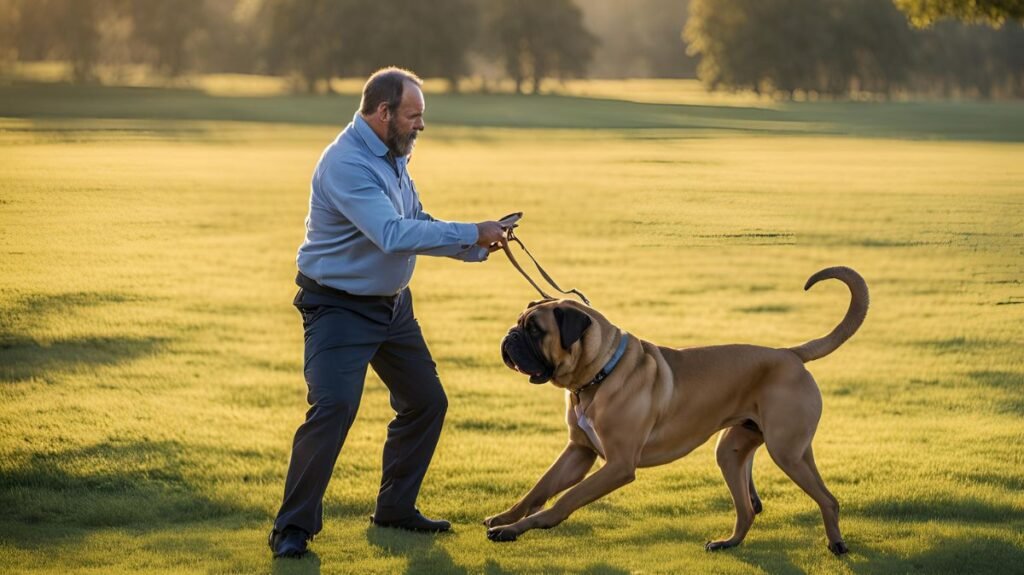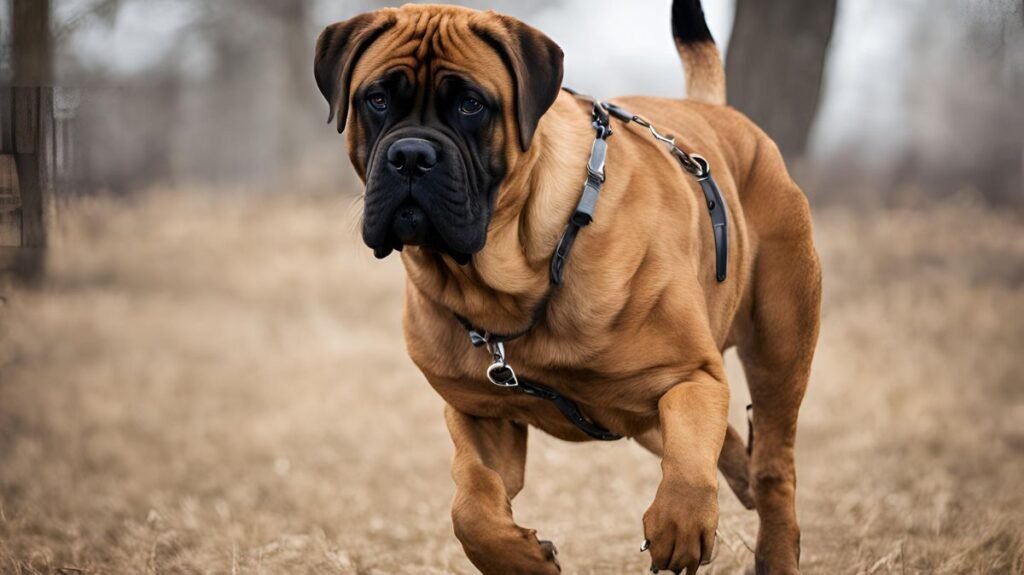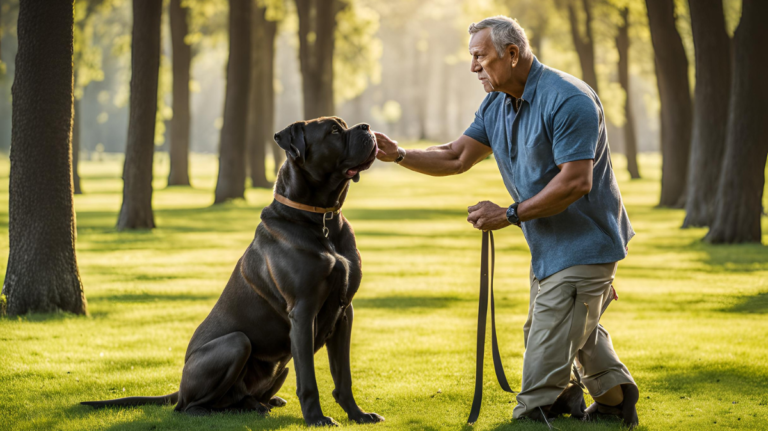Training a Bullmastiff requires patience, consistency, and understanding of their unique behavior. These gentle giants are known for their protective instincts and affectionate demeanor, making them both loyal companions and vigilant guardians.

Key Takeaways
| Aspect | Details |
|---|---|
| Breed Characteristics | Protective, affectionate, intelligent |
| Training Approach | Positive reinforcement and consistency |
| Common Challenges | Aggression, anxiety, stubbornness |
| Recommended Tools | Clickers, harnesses, treats |

Understanding Bullmastiff Behavior
Bullmastiffs are known for their natural instincts and unique temperament. Understanding their behavior is crucial for effective training:
- Instincts: Protective instincts towards family members.
- Temperament: Generally calm but can be stubborn at times.
Common Behavioral Challenges:
- Aggression towards strangers or other animals.
- Stubbornness during training sessions.
- Separation anxiety when left alone.
Essential Training Techniques
Utilizing the right techniques is vital for training your Bullmastiff effectively:
Positive Reinforcement
Positive reinforcement helps in encouraging good behavior:
- Use treats as rewards for following commands.
- Praise them with verbal affirmations like “Good boy!” or “Well done!”
Consistency in Training
Consistency is key. Keeping a regular schedule helps in maintaining progress:
- Train daily at the same time.
- Use the same commands consistently.
Quote: “Consistency and patience are the secrets of any successful training.”
Starting with Puppy Training
Initiating training early ensures a well-behaved Bullmastiff:
Importance of Early Socialization
Introduce your puppy to new experiences, people, and environments:
- Take them to dog parks.
- Arrange playdates with other puppies.
Basic Commands to Teach
Focus on foundational commands such as:
- Sit: Helps in maintaining control.
- Stay: Essential for safety.
- Come: Useful for recalls.

Advanced Obedience Training
As your Bullmastiff grows, introducing advanced commands helps maintain discipline and enhances their obedience.
Introducing Complex Commands
Consider incorporating commands beyond the basics:
- Heel: Walking beside you without a leash.
- Leave it: Ignoring distractions or off-limit items.
- Place: Going to a designated area and staying there.
List of Complex Commands:
- Sit and Stay
- Recall (Come)
- Heel
- Leave it
- Place
Maintaining Obedience Through Regular Practice
Regular practice is crucial for retaining learned behaviors:
- Frequent Reinforcement: Refresh and reinforce commands regularly.
- Interactive Sessions: Use games to incorporate training.
Addressing Behavioral Issues
Behavioral issues can be a challenge. It’s important to address these effectively.
How to Handle Aggression and Anxiety
Strategies to manage aggression and anxiety:
- Professional Guidance: Consider seeking help from a canine behaviorist.
- Calm Environment: Minimize stressful situations.
Tips for Managing Unwanted Behaviors:
- Stay Calm
- Redirect Attention
- Consistent Training
- Seek Professional Help

Strategies for Managing Unwanted Behaviors
Using consistent techniques can mitigate undesirable actions:
- Redirection: Shift focus to appropriate behaviors or activities.
- Timeouts: Use brief periods of isolation to discourage negative behavior.
Quote: “Understanding the root of aggression is the first step in addressing it.”
Exercise and Physical Activity
Exercise is crucial for a Bullmastiff’s physical and mental well-being.
Tailoring Exercise Routines for Bullmastiffs
Design an exercise plan that suits its size and energy level:
- Daily Walks: Essential for health and happiness.
- Playtime: Engage in activities like fetch or tug-of-war.
Benefits of Regular Physical Activity:
- Keeps them fit and healthy.
- Alleviates boredom and anxiety.
- Encourages socialization.
| Activity | Frequency |
|---|---|
| Walks | Twice a day |
| Play Sessions | Daily |
| Socialization | Weekly |
Training Tools and Equipment
Using the right tools can greatly enhance the training experience for both you and your Bullmastiff.
Recommended Gear for Effective Training
Selecting appropriate tools can assist in successful training sessions:
- Clickers: Useful for consistent training cues.
- Harnesses: Better control during walks and training.
- Treat Pouches: Handy for quick access to rewards.
List of Useful Training Tools:
- Clicker
- Harness
- Treat Pouch
- Training Collar
- Leash
Innovative Tools to Enhance Learning
New technologies can support and enhance learning outcomes:
- Interactive Toys: Keep your Bullmastiff engaged and stimulated.
- Training Apps: Provide a structured approach to training programs.
Quote: “The right tools in the right hands can transform any training challenge into a success.”
Creating a Training Schedule
A well-structured training schedule is essential for consistent progress.
Importance of a Structured Routine
A routine helps in establishing expectations and reinforcing learning:
- Sets a specific time for training every day.
- Balances training with rest and playtime.
Tips for Making an Effective Training Timetable
Crafting a flexible yet consistent plan can ensure success:
- Short Sessions: Keep training sessions brief to maintain attention.
- Diverse Activities: Alternate between different types of training to keep it interesting.
| Day | Training Activity |
|---|---|
| Monday | Basic Commands |
| Tuesday | Advanced Commands |
| Wednesday | Socialization |
| Thursday | Play and Exercise |
| Friday | Behavior Correction |
Building a Strong Bond
Training is not just about commands; it’s about fostering a connection between you and your Bullmastiff.
Enhancing the Owner-Dog Relationship
Building a solid bond ensures effective communication and trust:
- Shared Experiences: Participate in activities you both enjoy.
- Positive Reinforcement: Strengthen the emotional connection through rewards.
Emotional Benefits of Training Together
Training together not only strengthens skills but also builds a stronger emotional attachment:
- Increases Trust: Establishes a foundation of trust.
- Encourages Companionship: Deepens the mutual understanding and partnership.
Common Training Mistakes
Avoiding common pitfalls is essential for effective training and maintaining progress.
Pitfalls to Avoid During Training Sessions
Being aware of these mistakes can help in navigating the training journey:
- Inconsistency: Not maintaining a regular training routine.
- Lack of Patience: Expecting immediate results without allowing time for learning.
- Overuse of Negative Reinforcement: It can harm the emotional relationship.
List of Common Mistakes:
- Inconsistent Commands
- Impatience
- Harsh Punishments
- Irregular Training Times
Correcting Errors Effectively
Addressing mistakes promptly can keep training on track:
- Gentle Correction: Use gentle, firm words to correct undesirable behavior.
- Reinforce Desired Actions: Immediately reinforce with treats or affection when corrected behavior is displayed.
Quote: “Mistakes are just opportunities to learn and grow in the training process.”

Bullmastiff Training and Health
Training and health are interconnected; a healthy Bullmastiff is more likely to be receptive and engaged.
Connection Between Physical Health and Training
Ensuring good health can enhance training outcomes:
- Regular Vet Check-ups: Essential for maintaining overall wellness.
- Mental Stimulation: Keeping the mind sharp through varied activities.
Nutrition’s Impact on Behavior
A balanced diet supports both physical condition and behavior:
- High-Quality Food: Choose foods with optimal nutrients.
- Avoid Overfeeding: Excess weight can lead to lethargy and non-compliance.
| Health Aspect | Impact on Training |
|---|---|
| Regular Exercise | Increased Focus and Energy |
| Balanced Diet | Enhanced Behavioral Stability |
| Consistent Sleep | Improved Learning Retention |
Utilizing Professional Training Services
Sometimes, professional help can make training more effective and address challenges that require expertise.
When to Seek Expert Help
Consider professional services when:
- Behavioral Issues Persist: Aggression or anxiety that doesn’t improve.
- Need for Specialized Training: Advanced commands require expert guidance.
Benefits of Professional Training
Professionals offer a wealth of benefits:
- Experienced Techniques: Access to proven strategies and techniques.
- Personalized Programs: Customized training plans tailored to individual needs.
Quote: “Expert trainers bring a level of insight and technique that can be invaluable for overcoming behavioral challenges.”
Conclusion
Training a Bullmastiff is a rewarding journey that enriches both the owner’s and the dog’s lives. By employing positive reinforcement, maintaining consistency, and understanding the unique characteristics of the Bullmastiff, you can cultivate a well-behaved and happy companion. Remember, the bond between you and your Bullmastiff is the foundation of successful training. Always approach sessions with patience and love, and don’t hesitate to seek professional support when needed. For more insights, explore the resources available at Dog Training Expert.
Quote: “Training should be a joyful journey shared, where both learn and grow together.”

FAQ
What is the best age to start training a Bullmastiff?
The ideal age to start training a Bullmastiff is between 8 to 12 weeks. This is a critical period for socialization and learning basic commands.
How much exercise does a Bullmastiff need?
On average, a Bullmastiff needs about 30 to 45 minutes of exercise daily. It’s important to tailor this to their energy levels and physical condition.
Are Bullmastiffs easy to train?
Bullmastiffs are intelligent and eager to please, making them receptive to training when consistency and positive reinforcement are applied.
What should I do if my Bullmastiff shows aggression?
Seek expert advice if aggression persists. Professional trainers can offer effective strategies to manage and reduce aggression.




